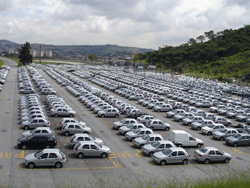 The first two quarters of 2018 have seen a 7% increase in the Latin American automotive market, with sales of light commercial and passenger vehicles increasing from 2.64m to 2.83m.
The first two quarters of 2018 have seen a 7% increase in the Latin American automotive market, with sales of light commercial and passenger vehicles increasing from 2.64m to 2.83m.
However, Felipe Munoz, global analyst of JATO Dynamics, comments that while the results are positive, the economies of the region have to grow more rapidly to really become a stronger and larger automotive market.
“Despite the upturn, Latin America continues to be a marginal market when compared to the world’s developed countries,” he says.
Significantly, however good current figures might look, they remain a long way from the record year of 2013. This is down to the poor performance of the Brazilian economy, which had record sales of 1.71 million units in the first half of 2013.
Vitor Klizas, president of JATO Dynamics Brazil notes, “Increased sales and local production [in Brazil] mean a significant 1.43 million units were produced in H1 and we anticipate further expansion during the rest of the year. As the market becomes more vibrant with more manufacturers, models and choice available for the consumer we expect results to continue to be positive.”
[mpu_ad]For its part, Mexico registered an 8.3% decline compared to the corresponding 2017 period, which broke all records. Despite this Gerardo San Roman, president of JATO Dynamics for Latin America is not totally downbeat in his analysis. “More than just a fall in sales, there was a deceleration in the Mexican market in H1 2018. But we do still see positive signs in key segments such as SUVs, premiums and alternative fuel vehicles. Mexico will continue to be a solid market of around 1.4 million units,” he says.
In contrast, both Argentina’s and Chile’s figures for 1H2018 proved to be the best in their history. However, major concerns remain regarding the former, where half year sales were up 11%, although with a notable fall of 17% in June, reflecting continuing currency fluctuations and the impact of economic austerity plans.
Chile benefited from a favourable exchange rate and great choice of models for consumers, with 200,000 units sold in a six-month period for the for the first time ever. SUV sales accounted for 34% of the total.
Despite a negative first quarter, results in Colombia ended the half 0.3% up, with 113,500 units sold. Wider model availability and falling prices in Ecuador resulted in a 56.6% increase in sales to 67,700 units.

























![Global[1]](https://d3n5uof8vony13.cloudfront.net/Pictures/web/a/d/s/global1_726550.svgz)









